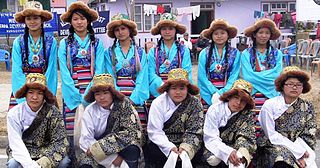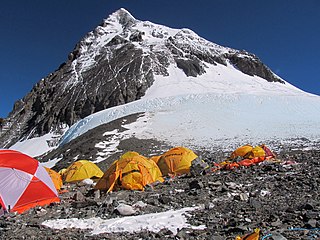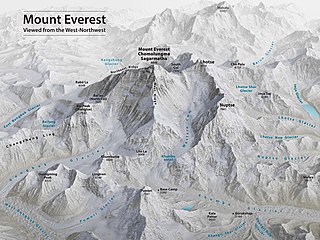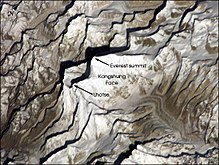
K2, at 8,611 metres (28,251 ft) above sea level, is the second-highest mountain on Earth, after Mount Everest at 8,849 metres (29,032 ft). It lies in the Karakoram range, partially in the Gilgit-Baltistan region of Pakistan-administered Kashmir and partially in the China-administered Trans-Karakoram Tract in the Taxkorgan Tajik Autonomous County of Xinjiang.

Mount Everest is Earth's highest mountain above sea level, located in the Mahalangur Himal sub-range of the Himalayas. The China–Nepal border runs across its summit point. Its elevation of 8,848.86 m was most recently established in 2020 by the Chinese and Nepali authorities.

The Sherpas are one of the Tibetan ethnic groups native to the most mountainous regions of Nepal and Tibetan Autonomous Region. The term sherpa or sherwa derives from the Tibetan-language words ཤར shar ('east') and པ pa ('people'), which refer to their geographical origin in eastern Tibet.

Lhotse is the fourth-highest mountain on Earth, after Mount Everest, K2, and Kangchenjunga. At an elevation of 8,516 metres (27,940 ft) above sea level, the main summit is on the border between Tibet Autonomous Region of China and the Khumbu region of Nepal.

The eight-thousanders are the 14 mountains recognised by the International Mountaineering and Climbing Federation (UIAA) as being more than 8,000 metres (26,247 ft) in height above sea level, and sufficiently independent of neighbouring peaks. There is no precise definition of the criteria used to assess independence, and at times, the UIAA has considered whether the list should be expanded to 20 mountain peaks by including the major satellite peaks of eight-thousanders. All of the eight-thousanders are located in the Himalayan and Karakoram mountain ranges in Asia, and their summits lie in an altitude known as the death zone.

The South Col is a col between Mount Everest and Lhotse, the highest and fourth-highest mountains in the world, respectively. The South Col is typically swept by high winds, leaving it free of significant snow accumulation. Since 1950, most Everest expeditions have left from Nepal and gone via the southeast ridge and the South Col. When climbers attempt to climb Everest from the southeast ridge in Nepal, their final camp is situated on the South Col.

Mount Everest is the world's highest mountain, with a peak at 8,849 metres (29,031.7 ft) above sea level. It is situated in the Himalayan range of Solukhumbu district, Nepal.
Lincoln Ross Hall OAM was a veteran Australian mountain climber, adventurer and author. Lincoln was part of the first Australian expedition to climb Mount Everest in 1984, which successfully forged a new route. He reached the summit of the mountain on his second attempt in 2006, miraculously surviving the night at 8,700 m (28,543 ft) on descent, after his family was told he had died.

David Sharp was an English mountaineer who died near the summit of Mount Everest. His death caused controversy and debate because he was passed by several other climbers heading to and returning from the summit as he was dying, although several others tried to help him.

The 1996 Mount Everest disaster occurred on 10–11 May 1996 when eight climbers caught in a blizzard died on Mount Everest while attempting to descend from the summit. Over the entire season, 12 people died trying to reach the summit, making it the deadliest season on Mount Everest at the time and the third deadliest after the 23 fatalities resulting from avalanches caused by the April 2015 Nepal earthquake and the 16 fatalities of the 2014 Mount Everest avalanche. The 1996 disaster received widespread publicity and raised questions about the commercialization of Everest.
Lopsang Jangbu Sherpa was a Nepalese Sherpa mountaineering guide, climber and porter, best known for his work as the climbing Sirdar for Scott Fischer's Mountain Madness expedition to Everest in Spring 1996, when a freak storm led to the deaths of eight climbers from several expeditions, considered one of the worst disasters in the history of Everest mountaineering. Notwithstanding controversy over his actions during that expedition, Lopsang was well-regarded in the mountaineering community, having summited Everest four times. Lopsang was killed in an avalanche in September 1996, while again on an expedition to climb Everest for what would have been a fifth ascent.

Premlata Agrawal is the first Indian woman to scale the Seven Summits, the seven highest continental peaks of the world. She was awarded the Padma Shri by the Government of India in 2013 and Tenzing Norgay National Adventure Award in 2017 for her achievements in the field of mountaineering. On 17 May 2011, she became the oldest Indian woman to have scaled the world's tallest peak, Mount Everest (29,032 ft.); at the age of 48 years at that time while Sangeeta Sindhi Bahl hailing from Jammu and Kashmir broke Premlata's record on 19 May 2018 and became the oldest Indian woman to scale Mount Everest doing it at the age of 53.

On 18 April 2014, seracs on the western spur of Mount Everest failed, resulting in an ice avalanche that killed sixteen climbing Sherpas in the Khumbu Icefall. This was the same icefall where the 1970 Mount Everest disaster had taken place. Thirteen bodies were recovered within two days, while the remaining three were never recovered due to the great danger in attempting such an expedition. Many Sherpas were angered by what they saw as the Nepalese government's meager offer of compensation to victims' families, and threatened a protest or strike. On 22 April, the Sherpas announced they would not work on Everest for the remainder of 2014 as a mark of respect for the victims.

The Mount Everest climbing season of 2017 began in spring with the first climbers reaching the top on May 11, from the north side. The first team on the south side reached the top on May 15. By early June, reports from Nepal indicated that 445 people had made it to the summit from the Nepali side. Reports indicate 160–200 summits on the north side, with 600–660 summiters overall for early 2017. This year had a roughly 50% success rate on that side for visiting climbers, which was down from other years. By 2018, the figure for the number of summiters of Everest was refined to 648. This includes 449 which summited via Nepal and 120 from Chinese Tibet.

The Mount Everest climbing season of 2013 included 658 summits and 8 deaths. Due to avalanches in 2014 and 2015, this was the last big summiting year until 2016.

Mount Everest climbing season included 245 summits on May 19, 2012, a record number of summits on a single day. It would take seven more years to break this record. This added congestion resulted in the highest fatality total since 1996. 683 climbers from 34 countries attempted to climb the mountain, and 547 people summited. A record was set in May when 234 climbers summitted on a single day. There were 11 deaths, some of which were attributed to overcrowding near the peak.

Mount Everest in 2018 is about events in the year about the highest Earth mountain, Mount Everest, a popular mountaineering tourism and science destination in the 2010s. In 2018, 807 climbers summited Mount Everest, which is a popular mountaineering goal. This year is noted for an especially long weather window of 11 days straight of calm, which reduced crowding at the high base camps. With over 800 reaching the top, it was the highest amount ever to reach the top in recorded history, besting the previous year by over 150 summitings.
















